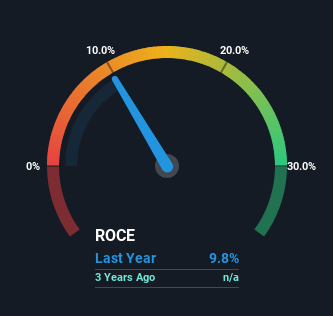- Japan
- /
- Professional Services
- /
- TSE:7031
Returns On Capital Signal Difficult Times Ahead For Inbound Tech (TSE:7031)

If you're looking at a mature business that's past the growth phase, what are some of the underlying trends that pop up? When we see a declining return on capital employed (ROCE) in conjunction with a declining base of capital employed, that's often how a mature business shows signs of aging. Basically the company is earning less on its investments and it is also reducing its total assets. So after glancing at the trends within Inbound Tech (TSE:7031), we weren't too hopeful.
What Is Return On Capital Employed (ROCE)?
Just to clarify if you're unsure, ROCE is a metric for evaluating how much pre-tax income (in percentage terms) a company earns on the capital invested in its business. To calculate this metric for Inbound Tech, this is the formula:
Return on Capital Employed = Earnings Before Interest and Tax (EBIT) ÷ (Total Assets - Current Liabilities)
0.098 = JP¥286m ÷ (JP¥3.7b - JP¥776m) (Based on the trailing twelve months to December 2023).
Thus, Inbound Tech has an ROCE of 9.8%. Ultimately, that's a low return and it under-performs the Professional Services industry average of 15%.
See our latest analysis for Inbound Tech

While the past is not representative of the future, it can be helpful to know how a company has performed historically, which is why we have this chart above. If you want to delve into the historical earnings , check out these free graphs detailing revenue and cash flow performance of Inbound Tech.
So How Is Inbound Tech's ROCE Trending?
We are a bit worried about the trend of returns on capital at Inbound Tech. To be more specific, the ROCE was 16% one year ago, but since then it has dropped noticeably. On top of that, it's worth noting that the amount of capital employed within the business has remained relatively steady. This combination can be indicative of a mature business that still has areas to deploy capital, but the returns received aren't as high due potentially to new competition or smaller margins. So because these trends aren't typically conducive to creating a multi-bagger, we wouldn't hold our breath on Inbound Tech becoming one if things continue as they have.
The Key Takeaway
In summary, it's unfortunate that Inbound Tech is generating lower returns from the same amount of capital. Investors haven't taken kindly to these developments, since the stock has declined 27% from where it was three years ago. Unless there is a shift to a more positive trajectory in these metrics, we would look elsewhere.
One more thing: We've identified 4 warning signs with Inbound Tech (at least 1 which is a bit unpleasant) , and understanding these would certainly be useful.
If you want to search for solid companies with great earnings, check out this free list of companies with good balance sheets and impressive returns on equity.
New: AI Stock Screener & Alerts
Our new AI Stock Screener scans the market every day to uncover opportunities.
• Dividend Powerhouses (3%+ Yield)
• Undervalued Small Caps with Insider Buying
• High growth Tech and AI Companies
Or build your own from over 50 metrics.
Have feedback on this article? Concerned about the content? Get in touch with us directly. Alternatively, email editorial-team (at) simplywallst.com.
This article by Simply Wall St is general in nature. We provide commentary based on historical data and analyst forecasts only using an unbiased methodology and our articles are not intended to be financial advice. It does not constitute a recommendation to buy or sell any stock, and does not take account of your objectives, or your financial situation. We aim to bring you long-term focused analysis driven by fundamental data. Note that our analysis may not factor in the latest price-sensitive company announcements or qualitative material. Simply Wall St has no position in any stocks mentioned.
About TSE:7031
Inbound Tech
Engages in the Multilingual CRM and sales outsourcing businesses in Japan.
Adequate balance sheet and slightly overvalued.
Market Insights
Community Narratives



